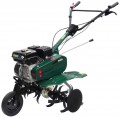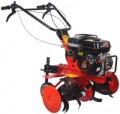Working width
The maximum width of the strip of land processed by the machine in one pass.
The large width makes it easier to work in large open areas, allowing them to be dealt with faster. At the same time, it is easier to deal with bottlenecks and hard-to-reach nooks and crannies with a small working width — a large unit may simply not fit where a smaller one will pass without problems. So it is worth choosing according to this indicator, taking into account the features of the planned work. If we talk about specific numbers, then in the smallest models the capture width
does not exceed 50 cm, in the largest it can be
1 m or more, a value
from 50 to 75 cm can be called average, and
from 75 cm to 1 m — above average.
Also note that some models allow you to expand the processing width by installing additional cutters. However, note that the wider the band, the more power is needed for efficient operation. It is believed that for the full use of the two-wheel tractor, it must produce at least 1 hp. for every 20 cm of width; however, for loose soils and shallow depths, smaller values are sufficient.
Number of gears
The number of gears provided in a self-propelled cultivator / two-wheel tractor, in other words, the number of travel speeds. There are both the simplest
two-wheel tractors for 1 gear or
2 gears, as well as more advanced ones with
three,
four and even
6 gears. Lower gears are not fast, but they allow you to effectively cope with high loads, and are also better suited for starting from a place; higher ones give low tractive effort, but good speed. Thus, the presence of several gears makes it possible to adjust the operating mode of the unit to the specifics of the situation. The number of gears is also relevant for reverse gear, because there are walk-
behind tractors and cultivators for 1 gear or
more.
Motor model
Model of the engine installed in the two-wheel tractor / cultivator. The main performance data of the engine is usually indicated in the general data for the unit. However, knowing the exact name of the motor, you can find more detailed information on it — starting from specific data like torque or revolutions and ending with reviews and reviews. Also, data on the engine model can be useful when searching for spare parts or consumables.
Engine size
The working volume of the gasoline or diesel engine of the cultivator / two-wheel tractor. For an internal combustion engine of the same type (see "Type of internal combustion engine"), power and fuel consumption usually directly depend on the volume. Also, the classification of a two-wheel tractor as a vehicle according to the traffic rules of a particular country may depend on the engine volume; you should pay attention to this if you plan to use the unit as a tractor and drive on roads.
Motor power
Motor block / cultivator engine power in watts. This designation is normally used for electric engines, but can also be used for gasoline/diesel engines, along with horsepower (for these, see Engine Power above).
A more powerful engine allows you to achieve higher productivity, width and depth of processing. On the other hand, high power significantly affects the price, weight and dimensions of the unit, as well as electricity / fuel consumption. In light of this, the engine power is selected by the manufacturer, taking into account which “weight category” the walk-behind tractor belongs to, what characteristics it should show. So, the lightest models have a power
of up to 1.5 kW, just such a device is best suited for a small area of 6 - 8 acres. Motoblocks
up to 3 kW are already able to cope with 10 - 15 acres, a power of
3.5 - 5 kW is suitable for a plot from 50 acres to a couple of hectares. Units
for 5 - 10 kW already belong to the professional level, they are "too tough" open spaces of 7 - 10 hectares; and the heaviest and most powerful modern walk-behind tractors have a power
of more than 10 kW.
Fuel consumption
The average amount of fuel consumed by the gasoline or diesel engine (see "Engine type") of the cultivator/two-wheel tractor per hour of operation. This value is rather conditional, because depending on the mode of operation, fuel consumption may vary in one direction or another; however, in general, it provides an estimate of the approximate amount of fuel required for a given operating time.
Crankcase oil capacity
The nominal volume of oil in the crankcase, in other words, is the amount of oil that must be in the engine for its normal operation. This parameter is relevant mainly for four-stroke units (see "Type of internal combustion engine") — in two-stroke units, usually, gasoline and oil are poured in the form of a mixture, and there is no separate container for lubrication. Certain deviations from this volume are allowed, but in general they are undesirable.

